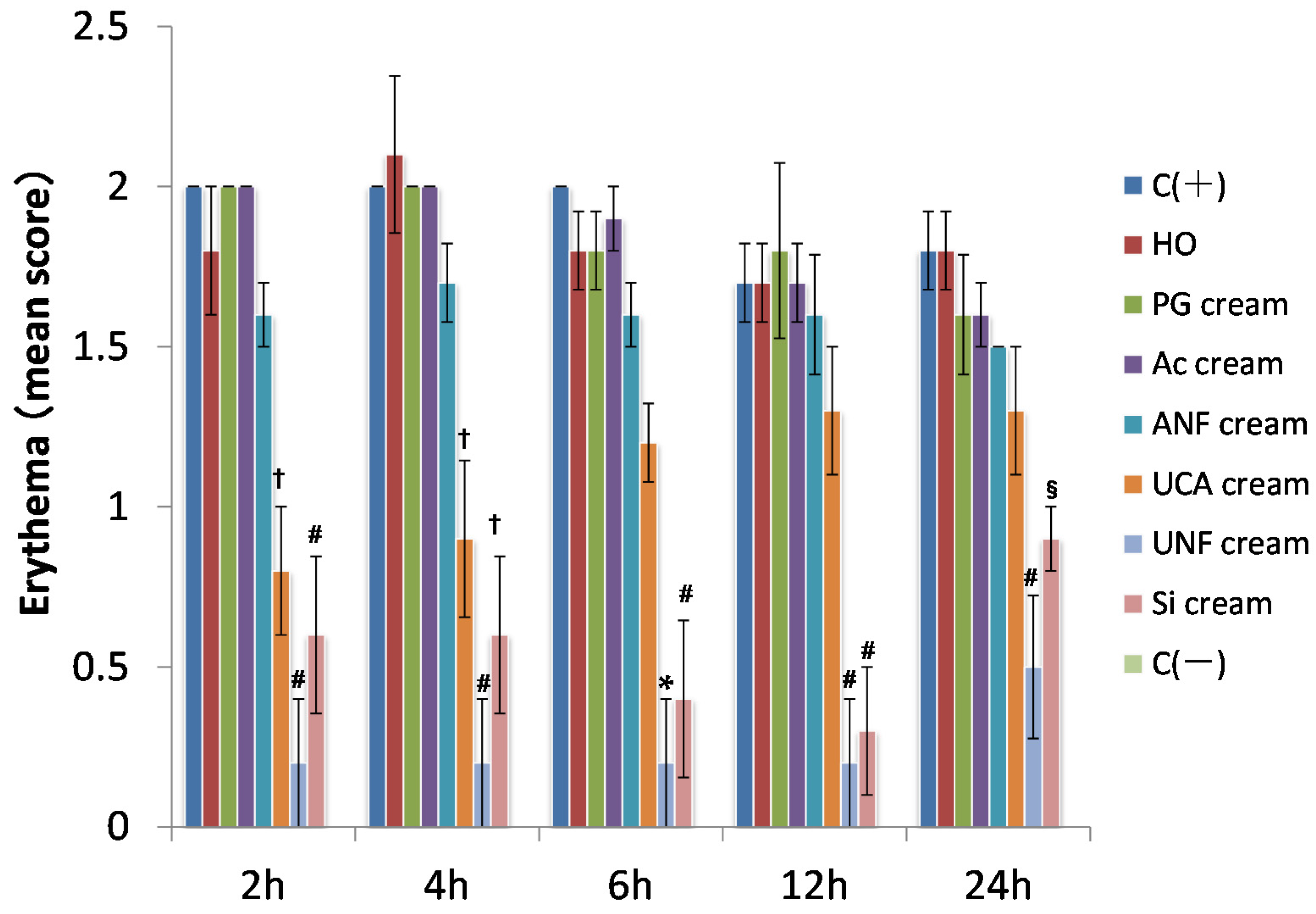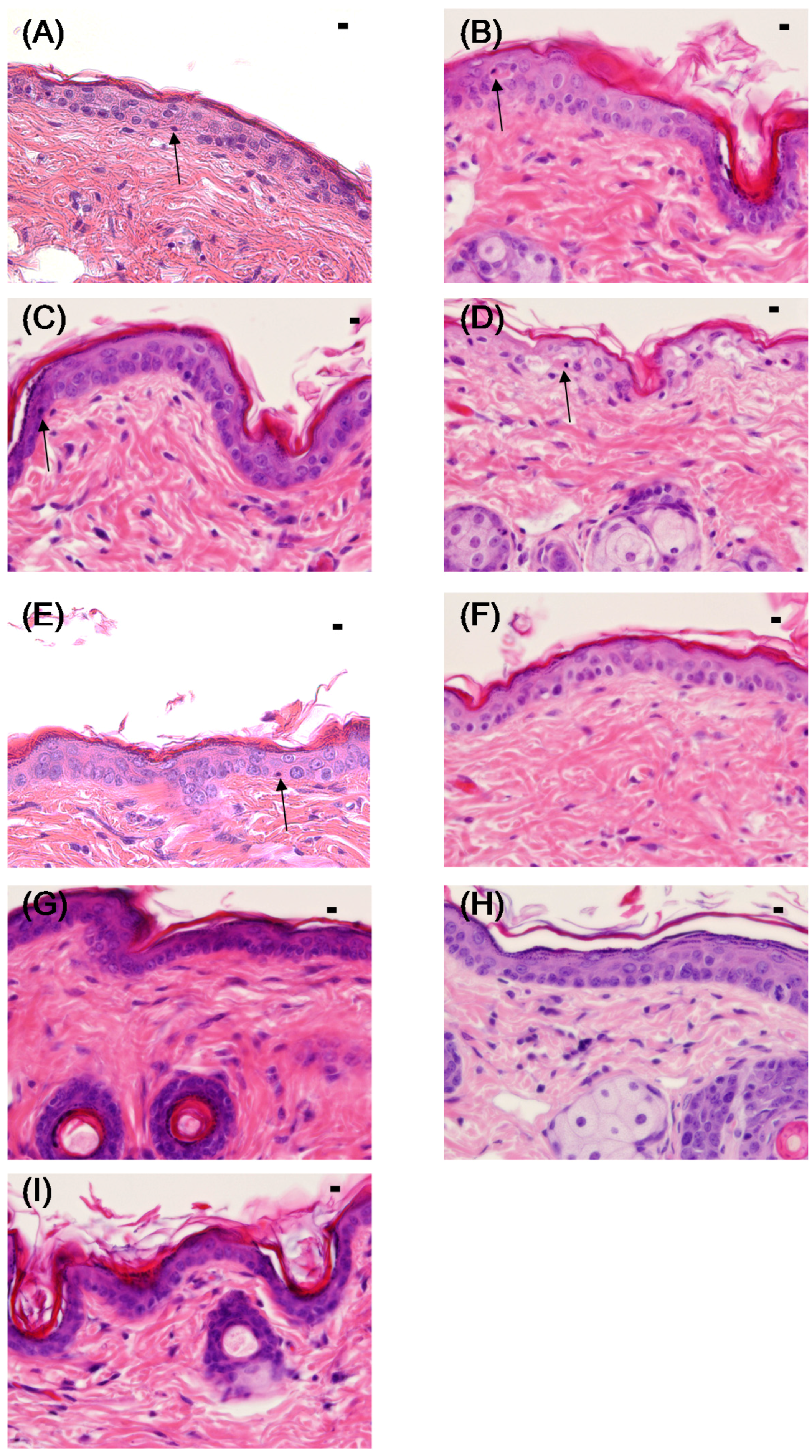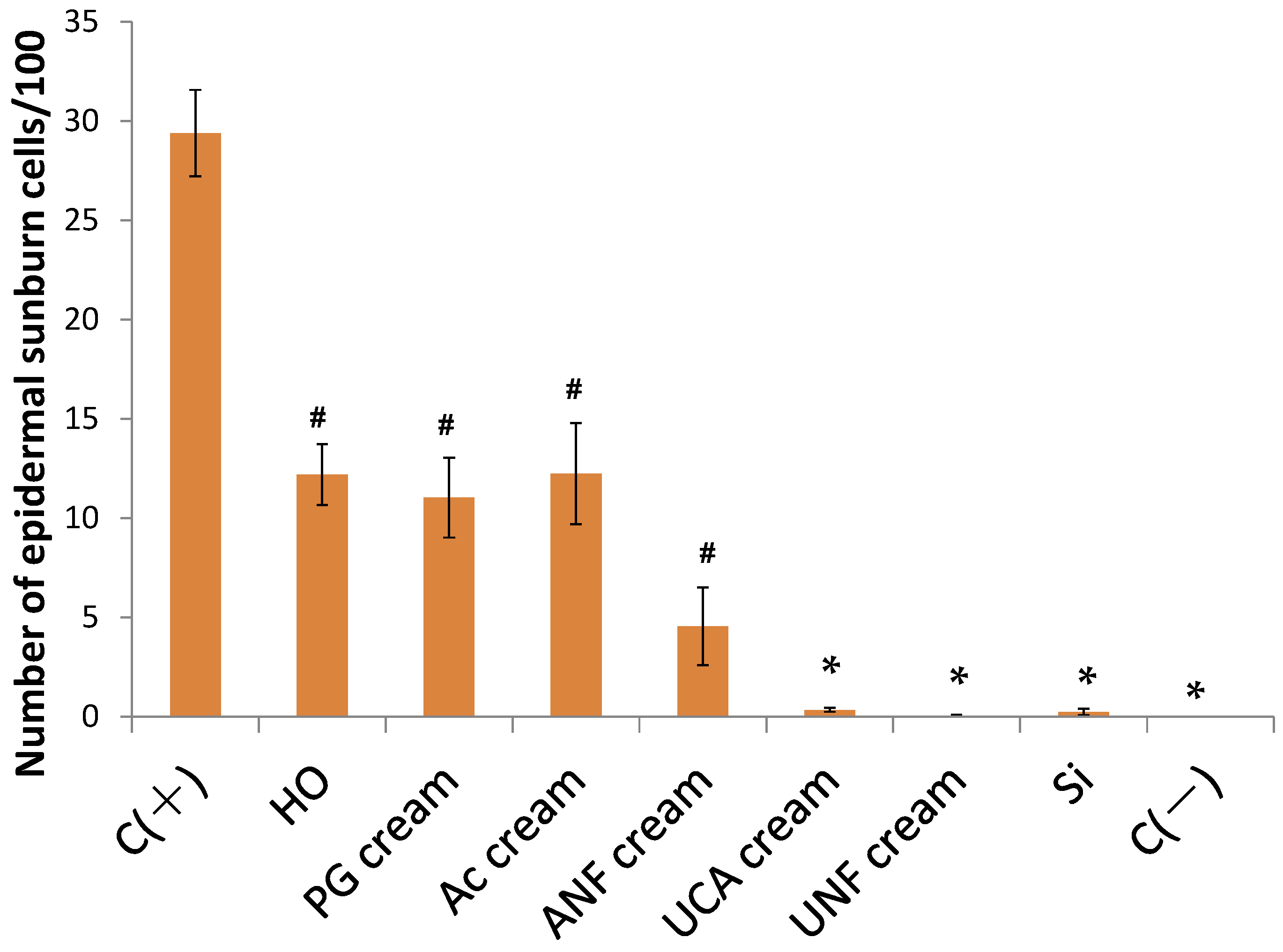Protective Effect of Chitin Urocanate Nanofibers against Ultraviolet Radiation
Abstract
:1. Introduction
1.1. DNA Damage and Skin Damage by UV Light
1.2. About UCA and Squid Ink as Positive Controls
1.3. About Chitin and Chiti Nanofibers
2. Results and Discussion
2.1. Erythema Score


2.2. Sunburn Cell Counts in the Epidermis



2.3. Conclusions in These Two Results
3. Experimental Section
3.1. Test Specimens
| Substances | 1 wt % Ac | HO | 35 wt % PG | ANFs | 0.2 wt% UCA in 35 wt% PG | 0.2 wt % UCA In 30 wt % PG | UNFs | 1 wt% SI in 35 wt % PG |
|---|---|---|---|---|---|---|---|---|
| Ac cream | 50 | 50 | ||||||
| HO | 100 | |||||||
| PG cream | 50 | 50 | ||||||
| ANFs cream | 49.59 | 50 | 0.41 | |||||
| UCA cream | 50 | 50 | ||||||
| UNFs cream | 50 | 49.5 | 0.5 | |||||
| SI cream | 50 | 50 |
3.2. Experimental Animal Model
3.3. Experimental Groups
3.4. Sample Application and UV Irradiation
3.5. Preparation of Irradiated Samples
3.6. Evaluation Methods
3.7. Statistical Analysis
4. Conclusions
Acknowledgments
Author Contributions
Conflicts of Interest
References
- Kobayashi, S. UVB-induced skin damage and the protection/treatment—Effects of a novel, hydrophilic gamma-tocopherol derivative. Yakugaku Zasshi 2006, 126, 677–693. [Google Scholar] [CrossRef] [PubMed]
- De Fabo, E.C.; Noonan, F.P. Mechanism of immune suppression by ultraviolet radiation in vivo. I. Evidence for the existence of a unique photoreceptor in skin and its role in photoimmunology. J. Exp. Med. 1983, 157, 84–98. [Google Scholar] [CrossRef]
- Sugawara, S.; Nizy, K. Sun Ultraviolet Light and Health; Shokaboh Press: Tokyo, Japan, 1998. [Google Scholar]
- Snyder, D.S. Effect of topical indomethacin on UVR-induced redness and prostaglandin E levels in sunburned guinea pig skin. Prostagrandins 1976, 11, 631–643. [Google Scholar] [CrossRef]
- Donaldson, M.R.; Coldiron, B.M. No end in sight: The skin cancer epidemic continues. Semin. Cutan. Med. Surg. 2011, 30, 3–5. [Google Scholar] [CrossRef] [PubMed]
- Boring, C.C.; Squires, T.S.; Tong, T. Cancer Statistics. CA Cancer J. Clin. 1992, 42, 19–38. [Google Scholar] [CrossRef] [PubMed]
- Narayanan, D.L.; Saladi, R.N.; Fox, J.L. Ultraviolet radiation and skin cancer. Int. J. Dermatol. 2010, 49, 978–986. [Google Scholar] [CrossRef] [PubMed]
- Yasuoka, S.; Takata, J.; Karube, Y.; Katoh, E.; Tsuzuki, T.; Kizu, J.; Tsuchiya, M.; Kobayashi, S. Topical application of a novel, water-soluble gamma-tocopherol derivative prevents UV-induced skin damage in mice. Photochem. Photobiol. 2005, 81, 908–913. [Google Scholar] [CrossRef] [PubMed]
- Mizukoshi, K.; Oshima, H.; Matsumoto, K.; Hirose, R.; Fujita, T. The effects of serine palmitoyltransferase inhibitor, ISP-I, on UV-induced barrier disruption in the stratum corneum. Biol. Pharm. Bull. 2010, 33, 2008–2012. [Google Scholar] [CrossRef] [PubMed]
- Mishra, A.K.; Mishra, A.; Chattopadhyay, P. Assessment of in vitro sun protection factor of Calendula officinalis L. (asteraceae) essential oil formulation. J. Young Pharm. 2012, 4, 17–21. [Google Scholar] [CrossRef] [PubMed]
- Ananthaswamy, H.N.; Loughlin, S.M.; Cox, P.; Evans, R.L.; Ullrich, S.E.; Kripke, M.L. Sunlight and skin cancer: Inhibition of p53 mutations in UV-irradiated mouse skin by sunscreens. Nat. Med. 1997, 3, 510–514. [Google Scholar] [CrossRef] [PubMed]
- Rawlings, A.V.; Harding, C.R. Moisturization and skin barrier function. Dermatol. Ther. 2004, 17, 43–48. [Google Scholar] [CrossRef] [PubMed]
- Baden, H.P.; Pathak, M.A. The metabolism and function of urocanic acid in skin. J. Investig. Dermatol. 1967, 48, 11–17. [Google Scholar] [PubMed]
- Walterscheid, J.P.; Nghiem, D.X.; Kazimi, N.; Nutt, L.K.; McConkey, D.J.; Norval, M.; Ullrich, S.E. Cis-urocanic acid, a sunlight-induced immunosuppressive factor, activates immune suppression via the 5-HT2A receptor. Proc. Natl. Acad. Sci. USA 2006, 103, 17420–17425. [Google Scholar] [CrossRef] [PubMed]
- Barresi, C.; Stremnitzer, C.; Mlitz, V.; Kezic, S.; Kammeyer, A.; Ghannadan, M.; Posa-Markaryan, K.; Selden, C.; Tschachler, E.; Eckhart, L. Increased sensitivity of histidinemic mice to UVB radiation suggests a crucial role of endogenous urocanic acid in photoprotection. J. Investig. Dermatol. 2011, 131, 188–194. [Google Scholar] [CrossRef] [PubMed]
- de Fine Olivarius, F.; Wulf, H.C.; Crosby, J.; Norval, M. The sunscreening effect of urocanic acid. Photodermatol. Photoimmunol. Photomed. 1996, 12, 95–99. [Google Scholar] [CrossRef] [PubMed]
- Viiri, J.; Jauhonen, H.-M.; Kauppinen, A.; Ryhänen, T.; Paimela, T.; Hyttinen, J.; Sorri, I.; Laihia, J.K.; Leino, L.; Kaarniranta, K. Cis-urocanic acid suppresses UV-B-induced interleukin-6 and -8 secretion and cytotoxicity in human corneal and conjunctival epithelial cells in vitro. Mol. Vis. 2009, 15, 1799–1805. [Google Scholar] [CrossRef] [PubMed]
- Brenner, M.; Hearing, J.V. The protective role of melanin against UV damage in human skin. Photochem. Photobiol. 2008, 84, 539–549. [Google Scholar] [CrossRef] [PubMed]
- Chen, P.Y.; Lin, A.Y.; McKittrick, J.; Meyers, M.A. Structure and mechanical properties of crab exoskeletons. Acta Biomater. 2008, 4, 587–596. [Google Scholar] [CrossRef] [PubMed]
- Raabe, D.; Romano, P.; Sachs, C.; Fabritius, H.; Sawalmih, A.A.; Yi, S.B.; Servos, G.; Hartwig, H.G. Microstructure and crystallographic texture of the chitin-protein network in the biological composite material of the exoskeleton of the lobster Homarus americanus. Mater. Sci. Eng. 2006, 421, 143–153. [Google Scholar] [CrossRef]
- Muzzarelli, R.A.; Morganti, P.; Morganti, G.; Palombo, P.; Palombo, M.; Biagini, G.; Belmonte, M.M.; Giantomassi, F.; Orlandi, F.; Muzzarelli, C. Chitin nanofibrils/chitosan glycolate composites as wound medicaments. Carbohydr. Polym. 2007, 70, 274–284. [Google Scholar] [CrossRef]
- Ifuku, S.; Nogi, M.; Abe, K.; Yoshioka, M.; Morimoto, M.; Saimoto, H.; Yano, H. Preparation of chitin nanofibers with a uniform width as alpha-chitin from crab shells. Biomacromolecules 2009, 10, 1584–1588. [Google Scholar] [CrossRef] [PubMed]
- Nalwa, H.S. Handbook of Nanostructured Biomaterials and Their Applications in Nanobiotechnology; American Scientific Publishers: Los Angeles, CA, USA, 2005. [Google Scholar]
- Nalwa, H.S. Encyclopedia of Nanoscience and Nanotechnology; American Scientific Publishers: Los Angeles, CA, USA, 2004. [Google Scholar]
- Azuma, K.; Ifuku, S.; Osaki, T.; Okamoto, Y.; Minami, S. Preparation and 4 biomedical applications of chitin and chitosan nanofibers. J. Biomed. Nanotechnol. 2014, 10, 2891–2920. [Google Scholar] [CrossRef] [PubMed]
- Kane, K.S.; Maytin, E.V. Ultraviolet B-induced apoptosis of keratinocytes in murine skin is reduced by mild local hyperthermia. J. Investig. Dermatol. 1995, 104, 62–67. [Google Scholar] [CrossRef] [PubMed]
- Schwarz, A.; Bhardwaj, R.; Aragane, Y.; Mahnke, K.; Riemann, H.; Metze, D.; Luger, T.A.; Schwarz, T. Ultraviolet-B-induced apoptosis of keratinocytes: Evidence for partial involvement of tumor necrosis factor-α in the formation of sunburn cells. J. Investig. Dermatol. 1995, 104, 922–927. [Google Scholar] [CrossRef] [PubMed]
- Weedon, D.; Searle, J.; Kerr, J.F.R. Apoptosis: Its nature and implication for dermatopathology. Am. J. Dermatopathol. 1979, 1, 133–144. [Google Scholar] [CrossRef] [PubMed]
- Ziegler, A.; Jonason, A.S.; Leffell, D.J.; Simon, J.A.; Sharma, H.W.; Kimmelman, J.; Remington, L.; Jacks, T.; Brash, D.E. Sunburn and p53 in the onset of skin cancer. Nature 1994, 372, 773–776. [Google Scholar] [CrossRef] [PubMed]
- Olson, R.L.; Gaylor, J.; Everett, M.A. Ultraviolet-induced individual cell keratinization. J. Cutan. Pathol. 1974, 1, 120–125. [Google Scholar] [CrossRef] [PubMed]
- Gavrieli, Y.; Sherman, Y.; Ben-Sasson, S.A. Identification of programmed cell death in situ via specific labeling of nuclear DNA fragmentation. J. Cell. Biol. 1992, 119, 493–501. [Google Scholar] [CrossRef] [PubMed]
- Ito, I.; Osaki, T.; Ifuku, S.; Saimoto, H.; Takamori, Y.; Kurozumi, S.; Imagawa, T.; Azuma, K.; Tsuka, T.; Okamoto, Y.; et al. Evaluation of the effects of chitin nanofibrils on skin function using skin models. Carbohydr. Polym. 2014, 101, 464–470. [Google Scholar] [CrossRef] [PubMed]
- Ngo, D.-N.; Kim, M.-M. Chitin oligosaccharides inhibit oxidative stress in live cells. Carbohydr. Polym. 2008, 74, 228–234. [Google Scholar] [CrossRef]
- Azuma, K.; Osaki, T.; Wakuda, T.; Ifuku, S.; Saimoto, H.; Tsuka, T.; Imagawa, T.; Okamoto, Y.; Minami, S. Beneficial and preventive effect of chitin nanofibrils in a dextran sulfate sodium-induced acute ulcerative colitis model. Carbohydr. Polym. 2012, 87, 1399–1403. [Google Scholar] [CrossRef]
© 2015 by the authors; licensee MDPI, Basel, Switzerland. This article is an open access article distributed under the terms and conditions of the Creative Commons by Attribution (CC-BY) license (http://creativecommons.org/licenses/by/4.0/).
Share and Cite
Ito, I.; Yoneda, T.; Omura, Y.; Osaki, T.; Ifuku, S.; Saimoto, H.; Azuma, K.; Imagawa, T.; Tsuka, T.; Murahata, Y.; et al. Protective Effect of Chitin Urocanate Nanofibers against Ultraviolet Radiation. Mar. Drugs 2015, 13, 7463-7475. https://doi.org/10.3390/md13127076
Ito I, Yoneda T, Omura Y, Osaki T, Ifuku S, Saimoto H, Azuma K, Imagawa T, Tsuka T, Murahata Y, et al. Protective Effect of Chitin Urocanate Nanofibers against Ultraviolet Radiation. Marine Drugs. 2015; 13(12):7463-7475. https://doi.org/10.3390/md13127076
Chicago/Turabian StyleIto, Ikuko, Toshikazu Yoneda, Yoshihiko Omura, Tomohiro Osaki, Shinsuke Ifuku, Hiroyuki Saimoto, Kazuo Azuma, Tomohiro Imagawa, Takeshi Tsuka, Yusuke Murahata, and et al. 2015. "Protective Effect of Chitin Urocanate Nanofibers against Ultraviolet Radiation" Marine Drugs 13, no. 12: 7463-7475. https://doi.org/10.3390/md13127076
APA StyleIto, I., Yoneda, T., Omura, Y., Osaki, T., Ifuku, S., Saimoto, H., Azuma, K., Imagawa, T., Tsuka, T., Murahata, Y., Ito, N., Okamoto, Y., & Minami, S. (2015). Protective Effect of Chitin Urocanate Nanofibers against Ultraviolet Radiation. Marine Drugs, 13(12), 7463-7475. https://doi.org/10.3390/md13127076







